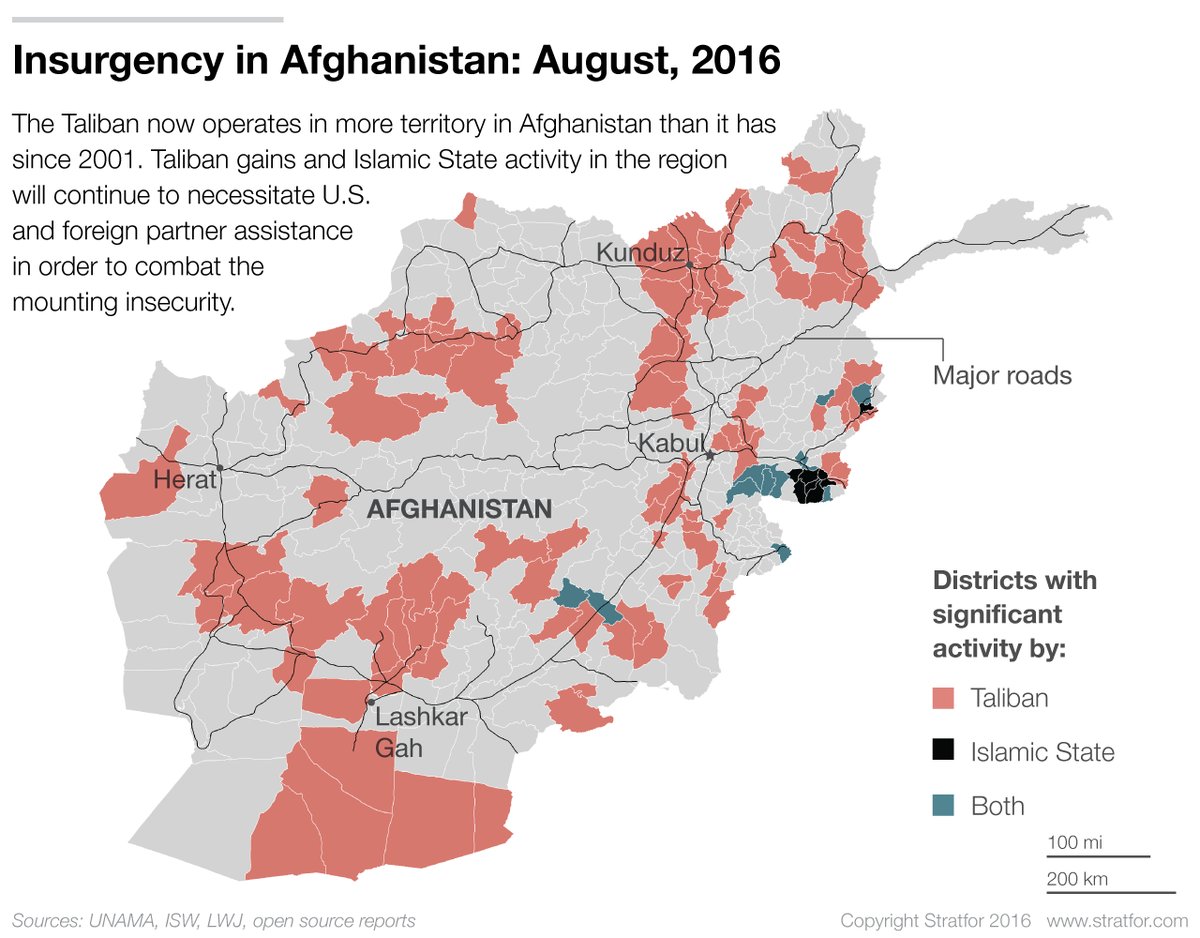Remember how the US presence in the Vietnam war ended? In a final exit via helicopters just before the North Vietnamese army entered Saigon. Is that where the 15 year American involvement in Afghanistan heading? If this sounds too dire, read on.
First the map tweeted by Stratfor in August 2016:
- Stratfor
@Stratfor – More on the Taliban insurgency and the scale of the U.S. military footprint in Afghanistan. http://social.stratfor.com/3FL03057wqd
This map is scary because it shows how the Taliban are expanding their sway all over the perimeter of Afghanistan & now marching inwards towards the center. That is the jist of the Stratfor report of October 12, 2016 titled Taliban Target the Country’s Regional Capitals.
- “In what appears to be one of the worst massacres of Afghan forces in a protracted and forgotten war, at least 100 were killed when the Taliban fighters opened fire on them from all directions as they tried to flee through the agreed-upon retreat route, Afghan officials said Wednesday.”
- “Accounts of the massacre, which happened Tuesday near the southern city of Lashkar Gah in Helmand Province, punctuated a growing crisis in Afghanistan’s armed forces that goes to the heart of their sustainability: They are sustaining enormous casualties from a revitalized Taliban insurgency and are facing increased problems recruiting. Many vacancies go unfilled.”
Lashkar Gah is the regional capital of Helmand Province that is adjacent to the Pushtun areas of NaPakistan. That makes it critical to both the Afghani Government & to the military-terrorism complex of the NaPak army. The NYT article quoted Mr. Chakhansuri, an assistant to Afghan President Ghani:
- Mr. Chakhansuri attributed the recent intensity of the war to insurgents receiving what he described as unprecedented support from Pakistan, long accused of harboring the Taliban as a proxy. “We can see there is a lot of truth and evidence — in the examples of fighting in Uruzgan and Kunduz — that terrorist groups and their operations are led by foreigners and generals, and they are receiving military and financial support from outside Afghanistan,” he said. “The way this war is managed, it shows that this is done by experts. This is very clear.”
The Taliban advance in provinces that border NaPakistan is only a part of the Taliban strategy. As Kamran Bokhari of Geopolitical Futures wrote in his article on October 10 titled Afghan Government Staring at the Abyss:
- “The Taliban have actually been gaining ground in many provinces that share a border with Central Asian nations. … dozens of Afghan security forces surrendered to the Taliban at a base in the Morichaq area of Bala Murghab district in Badghis province, near the border with Turkmenistan. According to reports, the Taliban are eyeing the southwestern province of Farah (along the border with Iran) where there has been an increase in fighting. In another noteworthy development, Afghanistan’s private TV channel Shamshad reported on Oct. 6 that the Taliban have managed to penetrate the Hazara Shiite community in Bamyan province, where they have established a branch.”
Speaking of Farah near the Iranian border, Stratfor reported on October 11, the day after Bokhari’s article:
- “… Taliban fighters attacked Farah, the capital of Farah province, as well as the smaller town of Ghormach. According to the latest reports, the militants have captured the latter and have seized an entrance to Farah, though the battle for control over the rest of the city is still underway”
Take a real look at the map above & you will see that the Taliban are slowly & methodically winning areas that border all the neighbors of Afghanistan, Iran, Turkmenistan, Uzbekistan, Tajikistan & of course NaPakistan, the godfather regime of the Taliban.
- One of two things must happen:
- Either Afghan security forces must gain the organizational strength required to turn the tide against the Taliban or
- the United States must deploy hundreds of thousands of troops to counter the Taliban insurgency. The latter is extremely unlikely to happen, considering that the United States is not even deploying many forces in Syria and Iraq where the stakes are far higher than in Afghanistan.
The first seems impossible because “the Afghan government is still unable to function” despite massive assistance from America & the West over 15 years. And the second is extremely unlikely, an analytical term for forget about it. So what has Geopolitical Futures begun doing?
- “we have to begin considering a scenario in which the Taliban could overwhelm the Afghan state“
In that case, how will the American contingent in Kabul leave land-locked Afghanistan? In a convoy of helicopters just like in Vietnam?
As you can see from the debates, no one in America is focused on Afghanistan, the place where terrorism against America first began and where the original Al Qaida was born.
That will change if & when Americans are forced to leave Afghanistan in a rush that is captured on TV. And who will be the winner? The same godfather regime that gave birth to the Taliban, fed it, nurtured it, protected it against American wrath after 9/11 and then unleashed it against American presence in Afghanistan after American attention got diverted to Iraq, then Libya & now Syria.
So how will America treat this godfather regime after the Taliban take Kabul? Simple – America will anoint it again as America’s critical ally in the war against terror and ask its support in controlling its children, the victorious Taliban.
How will that regime react? How do you say “Happy Days are here again” in Urdu?
